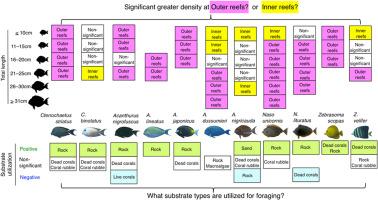Spatial distributions and foraging substrates of 11 surgeonfish species (family Acanthuridae) in an Okinawan coral reef
IF 2.6
3区 地球科学
Q1 MARINE & FRESHWATER BIOLOGY
引用次数: 0
Abstract
Surgeonfishes (family Acanthuridae) are a main fish group in coral reefs. This study aimed to examine the species-specific and size-related spatial distribution, and foraging substrates of 11 surgeonfish species in relation to topographical features and substrate diversity. Six species (Ctenochaetus striatus, Acanthurus nigrofuscus, A. lineatus, A. japonicus, Naso lituratus, and Zebrasoma scopas) showed a greater density in the outer reefs with a higher coverage of rock. The former five species showed a significant positive utilization of rock as foraging substrate, whereas Z. scopas positively utilized dead corals and rock. For A. dussumieri and N. unicornis, greater densities of smaller-sized individuals were found in the inner reefs with higher coverage of coral rubble and sand, whereas larger-sized individuals were found in the outer reefs with a higher coverage of rock. Naso unicornis showed a significantly positive utilization of rock as foraging substrate. Ctenochaetus binotatus tended to show greater density in the outer reefs and a significant positive utilization of rock as a foraging substrate. Acanthurus nigricauda tended to show greater density in the inner reefs and a significant positive utilization of sand as foraging substrate. Zebrasoma velifer showed greater density of smaller-sized individuals in the inner reefs with higher coverage of live corals and dead corals, whereas larger-sized individuals tended to be greater in the outer reefs with a higher coverage of rock. Zebrasoma velifer showed a significant positive utilization of dead corals as foraging substrate. These results indicated that non-coralline substrates are the main indicator for maintaining surgeonfish species diversity.

冲绳珊瑚礁11种刺尾鱼的空间分布及其觅食基质
刺鳍鱼(刺鳍科)是珊瑚礁中的主要鱼类。本研究旨在探讨11种刺尾鱼的物种特异性和大小相关性空间分布、觅食基质与地形特征和基质多样性的关系。纹缕毛毡、黑棘毛毡、线纹毛毡、日本毛毡、斜纹毛毡和斑马鱼在岩石盖度较高的外礁区密度较大。前5种植物对岩石有显著的正向利用,而大角藻对死珊瑚和岩石有显著的正向利用。在珊瑚碎石和沙子覆盖度较高的内礁和岩石覆盖度较高的外礁中,小体型个体密度较高,而在沙石覆盖度较高的外礁中,小体型个体密度较高。独角兽对岩石的利用表现出显著的正向效应。双爪毛鲸在外礁的密度更大,对岩石作为觅食基质的利用也更积极。黑棘蜥在暗礁内的密度更大,对沙子作为觅食基质有显著的正向利用。斑马鱼在活珊瑚和死珊瑚盖度较高的内礁中,体型较小的个体密度较大,而在岩石盖度较高的外礁中,体型较大的个体密度较大。斑马鱼对死珊瑚有显著的正向利用。这些结果表明,非珊瑚底物是维持刺尾鱼物种多样性的主要指标。
本文章由计算机程序翻译,如有差异,请以英文原文为准。
求助全文
约1分钟内获得全文
求助全文
来源期刊
CiteScore
5.60
自引率
7.10%
发文量
374
审稿时长
9 months
期刊介绍:
Estuarine, Coastal and Shelf Science is an international multidisciplinary journal devoted to the analysis of saline water phenomena ranging from the outer edge of the continental shelf to the upper limits of the tidal zone. The journal provides a unique forum, unifying the multidisciplinary approaches to the study of the oceanography of estuaries, coastal zones, and continental shelf seas. It features original research papers, review papers and short communications treating such disciplines as zoology, botany, geology, sedimentology, physical oceanography.

 求助内容:
求助内容: 应助结果提醒方式:
应助结果提醒方式:


